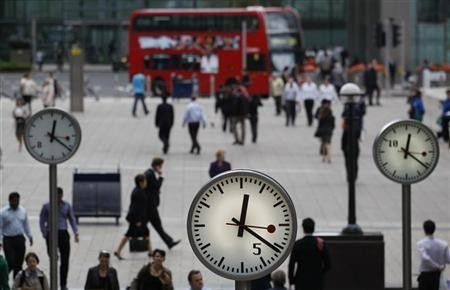Time for Decision on Removing Leap Seconds

(Reuters) - Experts have recommended eliminating leap seconds from the time scale used by most computer systems, but governments are split on the issue, to be decided this week, the International Telecommunications Union (ITU) said Tuesday.
Leap seconds, introduced in 1972 as part of Coordinated Universal Time (UTC), are added some years to reconcile the difference between atomic time used by computer systems and time as defined by measuring the movement of the earth around the sun and the earth's rotation.
The latter, known as Universal Time, fluctuates due to the earth's irregular rotation, tides or earthquakes.
"This will be an important decision because the problem of introducing the leap second will disappear and we will be able to have a more standard time than the one we have today," Vincent Meens, who headed an ITU experts' group that recommended removing leap seconds, told reporters.
"Time is very, very important for synchronization of all the radiocommunications systems. For instance, a lot of systems are using GPS time just to synchronize themselves and that would be very important for everybody to have the same time," he said, referring to satellite navigation systems.
The Geneva-based ITU is the U.N. agency responsible for coordinating international communications standards. Its radiocommunication assembly is due to debate the issue on Thursday, but clear divisions remain, officials said.
Britain is the staunchest defender of the leap second, backed by China and Canada with tacit support from Russia, while the United States and France are leading the call for its abolition, they said.
"It is not customary for the ITU conferences to vote, so we'll really do all our efforts to avoid that," said Francois Rancy, director of ITU's radiocommunications bureau.
"CONTINUOUS TIME SCALE"
Over the past 40 years, 34 seconds have been added to UTC, a spokesman said.
The ITU, a United Nations agency, said in a statement: "The benefits of the change would be a continuous time scale available for all the modern electronic navigation and computerized systems to operate with and eliminate the need for specialized ad hoc time systems."
ITU officials had no cost estimate for the proposed change, which would take effect from January 2018 if agreed by the assembly and endorsed by ITU's radiocommunication conference being held from Jan 23-Feb 17.
As a leap second has to be added manually at short notice to software programs on June 30 or December 31, users - from cell phone operators to air traffic control authorities - must doublecheck changes to avoid awkward glitches.
A disadvantage of abandoning leap seconds would be a growing discrepancy with solar time, which could be corrected by adding a single leap minute or hour at some point, officials said.
"The deviation of the leap second is about 1 minute and 30 seconds per century. The deviation for a millennium will be on the order of 15 minutes," Meens said.
The conference, held every four years, allocates radio frequencies for services ranging from meteorological services to GPS, radars, broadcasting and mobile phones.
© Copyright Thomson Reuters 2024. All rights reserved.




















